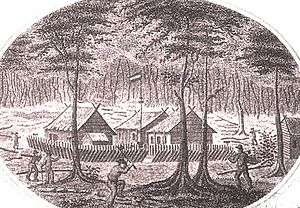Fort Du Bus


Fort Du Bus was a Dutch administrative and trading post established in 1828 on Triton Bay on the southwest coast of New Guinea, in the current Indonesian province of Papua. Intended to counter British encroachment, it was the first European settlement in the region; it was, however, abandoned in 1835, due to unhealthy climate and attacks by natives.
Background
Dutch New Guinea in the early 19th century was administered from the Moluccas. Although the coast had been mapped in 1825 by Lieutenant Commander D.H. Kolff, there had been no serious effort to establish a permanent presence in Dutch New Guinea. The British, however, had shown considerable interest in the area, and were threatening to settle it. To prevent this, the Governor of the Moluccas, Pieter Merkus, urged the Dutch government to establish posts along the coast. On December 31, 1827 a royal authorization was issued, and on April 21, 1828 a small expedition led by Lieutenant Jan Jacob Steenboom, with two ships, the corvette Triton and the schooner Iris, left Ambon to search for a suitable location for a settlement. Lieutenant Commander C.J. Boers accompanied the expedition to make nautical observations and carry out further exploration. Five naturalists - Dr. H.C. Macklot (zoologist), Gerrit van Raalten (taxidermist), Pieter van Oort (artist), Salomon Müller (zoologist/botanist), and Alexander Zippelius (botanist) - were also on board.[1]
Exploration
After a stop at Banda on April 25, Triton and Iris continued on to New Guinea. Prospective sites on Dourga Strait and the Oetanata River proved impractical due to swampy land and reefs. At one point several officers and men were injured in an attack by natives. In early July Lt. Steenboom finally located a suitable site at the head of a small enclosed bay (promptly named Triton Bay), just east of the modern coastal town of Kaimana.[2][3]
Outpost
The ships remained with the settlers for two months, their crews helping construct several small buildings surrounded by a double palisade. On August 24, 1828, the birthday of King William I of the Netherlands, the Dutch flag was hoisted, and Dutch claims on New Guinea were pronounced. Several local native chieftains proclaimed their loyalty to the Netherlands. The post was named Fort Du Bus for the then-Governor General of the Dutch East Indies, Leonard du Bus de Gisignies.[4][5]
The settlement carried out brisk trade with the coastal Asmat and the Papuans of the interior, as well as Ceramese traders who arrived in roofed-over, 15- to 30-foot long prahus. The Dutch bartered for massoia bark, aromatic woods, nutmeg, trepang, birds of paradise, and edible bird's nests.The inhabitants of the settlement, however, were afflicted by diseases (primarily malaria) and raids by natives from Ceram and Goram. In 1835 the surviving settlers were taken away, and Fort Du Bus was given back to nature.
In 1839 the French explorer Jules Dumont d'Urville visited the site and found an avenue of coconut palms, a lemon grove, and a few remains of buildings. Dutch colonial officials continued to visit Triton Bay on a sporadic basis.[6]
References
- ↑ 1928. GF Mees. Vogel medical examination in New Guinea in 1828. Ornithological results of the journey of Corvette Triton to the southwest coast of New Guinea
- ↑ 1928. GF Mees. Vogel medical examination in New Guinea in 1828. Ornithological results of the journey of Corvette Triton to the southwest coast of New Guinea
- ↑ Supplementary Papers, Volume 1; Royal Geographical Society (Great Britain), J. Murray, 1886; http://books.google.com/books?id=g-KfAAAAMAAJ&dq=fort+du+bus&source=gbs_navlinks_s; retvd 5 12 14
- ↑ Supplementary Papers, Volume 1; Royal Geographical Society (Great Britain), J. Murray, 1886; http://books.google.com/books?id=g-KfAAAAMAAJ&dq=fort+du+bus&source=gbs_navlinks_s; retvd 5 12 14
- ↑ 1928. GF Mees. Vogel medical examination in New Guinea in 1828. Ornithological results of the journey of Corvette Triton to the southwest coast of New Guinea
- ↑ Supplementary Papers, Volume 1; Royal Geographical Society (Great Britain), J. Murray, 1886; http://books.google.com/books?id=g-KfAAAAMAAJ&dq=fort+du+bus&source=gbs_navlinks_s; retvd 5 12 14